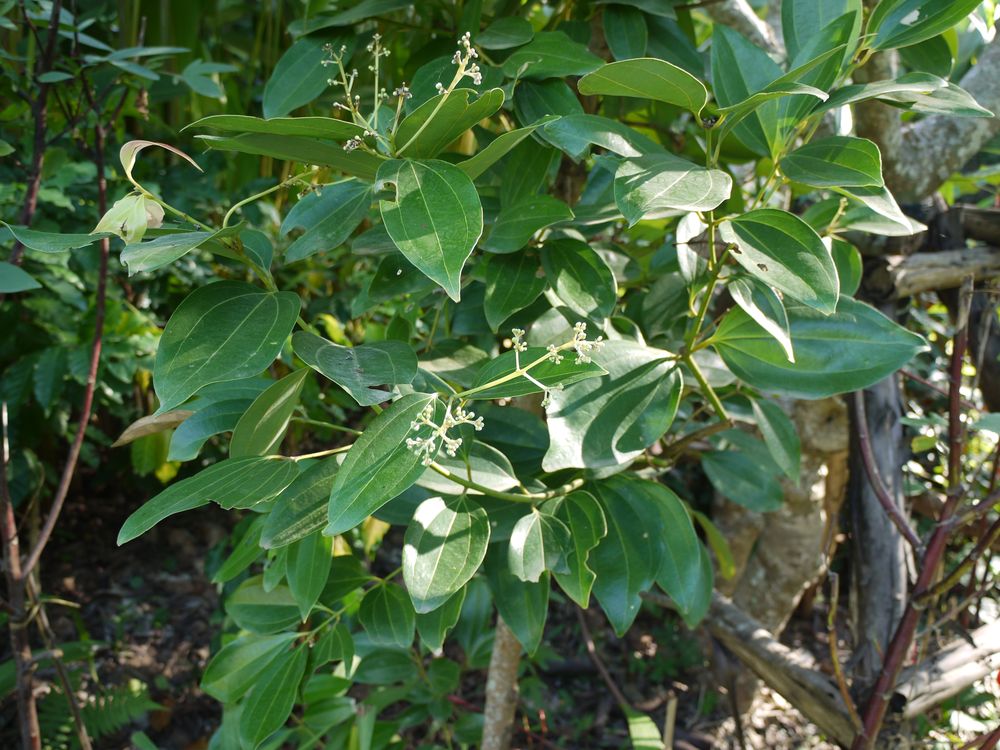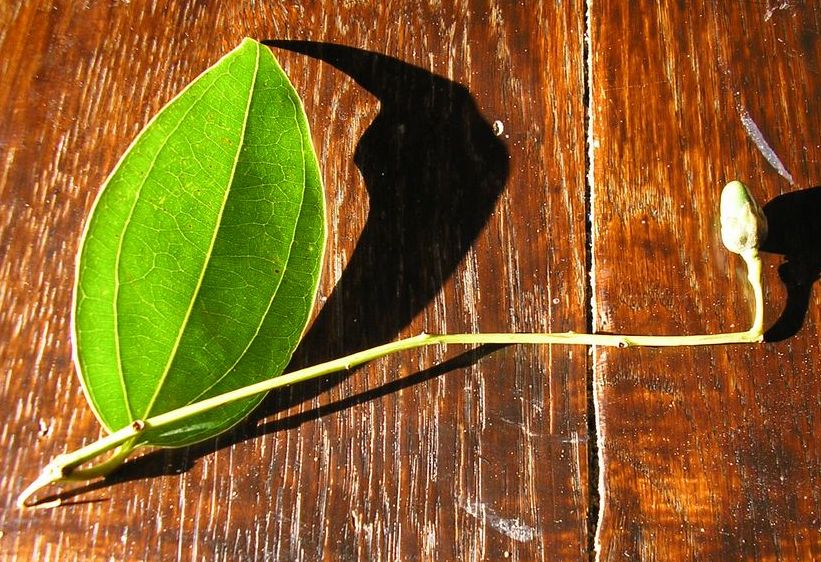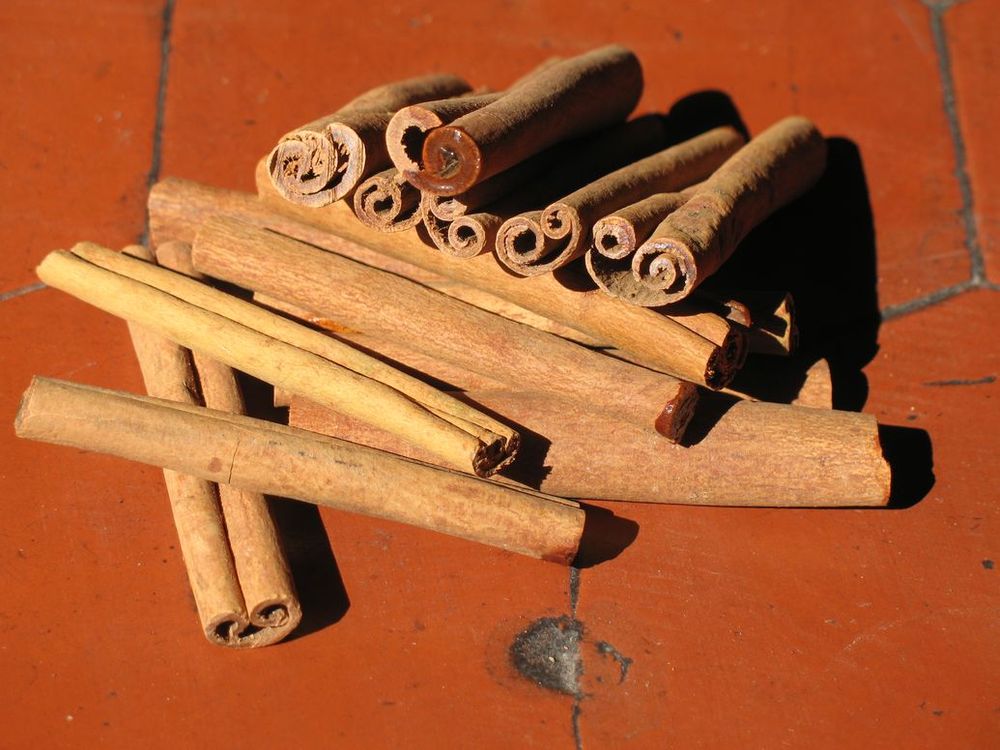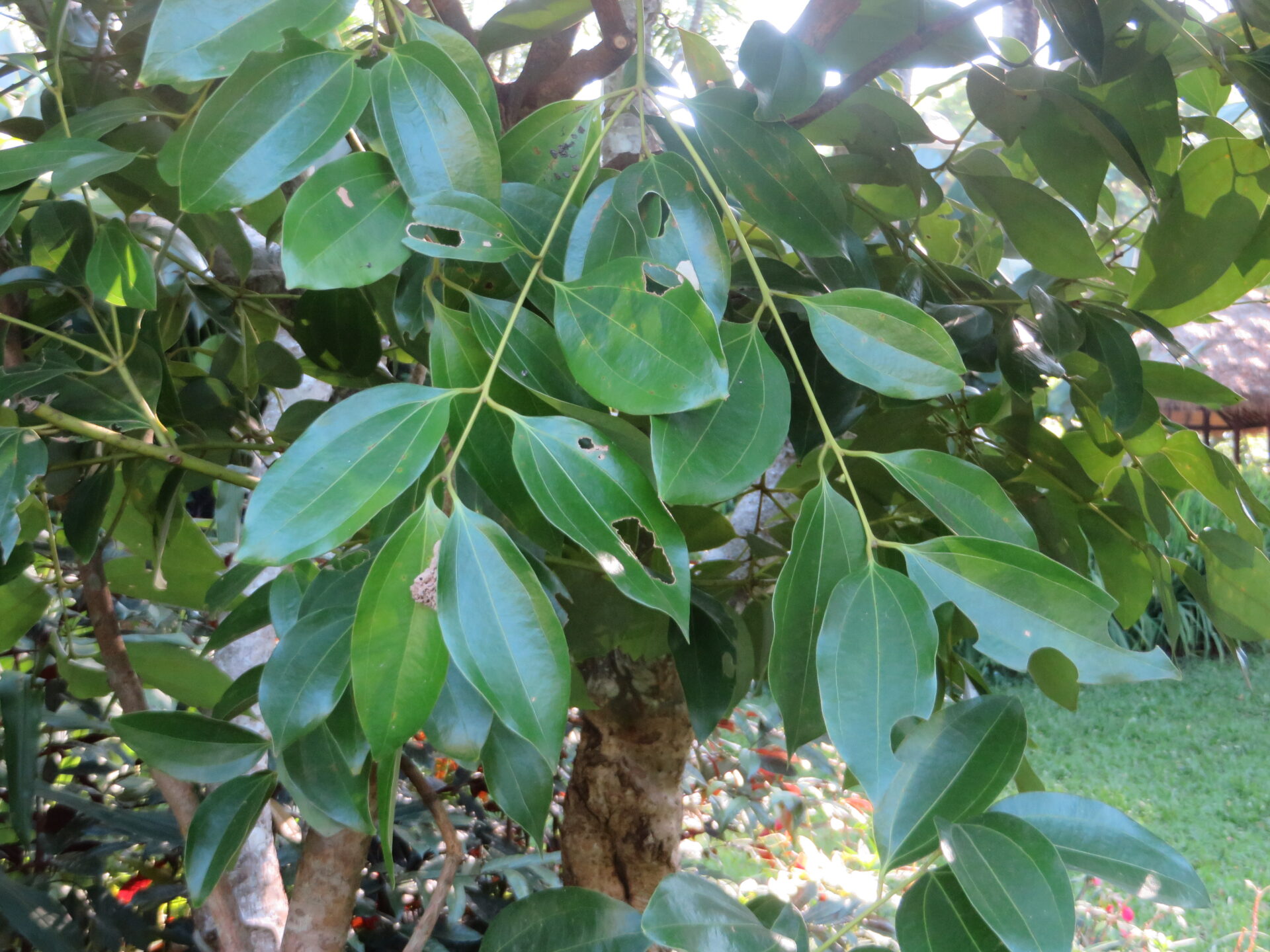Cinnamon, the bark of the cinnamon tree, is one of the most sought-after spices in the West, yet it is not very popular in Laos, despite the fact that certain varieties are endemic to the country.
True cinnamon originates from Ceylon but its name is an enigma. According to some, it comes from the Greek word kinnamômom, which refers to a more or less legendary plant, mentioned in numerous Greek texts. Others take up an etymology proposed in the 17th century: the merchants had given this bark the name of Cin-a-momum, because these two words mean “wood from China and which smells good” (Thévenot). What is certain is that the first cinnamon known in the West came from China, where it has always been part of the pharmacopoeia (Cinnamomum cassia), later supplanted by that of Ceylon.
Indeed, the history of cinnamon goes back to the earliest Antiquity; it was transported by Chinese ships to Egypt (where it was used to embalm the dead), to Asia Minor (it is mentioned in the Bible), to the Greek and Roman empires (Pliny gives an exact description). Later the Portuguese navigators, after invading the island of Ceylon, forced the Sinhalese kings to pay tribute in the form of cinnamon. Then, it was the Dutch and then the English, through the famous India Company, who regulated the plantation and trade of the precious spice.
Cinnamon trees are small, evergreen trees with shiny, leathery leaves, small, inconspicuous yellow flowers and small greenish fruits. They belong to the Lauraceae family, which includes 2500 species, mainly in the warmer regions of the world, including camphor, Mediterranean laurel and avocado.
The trees are pruned every two years to remove the bark from the branches when the sap rises. After cutting the bark, the cinnamon “peelers” tap the woody part with a mallet, which has the effect of detaching the outer part of the cambium. The bark thus removed tends to curl up on itself when drying, hence the name cinnamon (cane, tube). This bark, powdered or not, has multiple uses, both in pastries (apple or chocolate cake, ice cream, etc.) and in savoury preparations (stews, legs, etc.). It is traditionally added to coffee and is used to flavor many alcoholic drinks (wine, punch). As the hot spice par excellence, it is used to make toddies and aphrodisiac potions. It is said to be digestive, antispasmodic, tonic and stimulating.
From the leaves of the cinnamon tree and part of the bark, a very rich oil is extracted, much sought after by perfumers throughout the world. In France, it is used in the composition of “Opium” by Yves Saint-Laurent or “Poison” by Dior. It should be noted, however, that C. verum essential oil can sometimes be toxic, causing allergies, eye burns or erythema.
What about in Laos? In the North, Chinese cinnamon grows spontaneously and is called sa tiouang, i.e. “false cinnamon” (Cinnamomum cassia). The leaves are used by various ethnic groups (the Khmou, the Hmong) in decoction as a tonic, particularly for young women giving birth. The bark is also used as a scented stick by the Hmong, who call the plant xyab phij. Other varieties are found in the wild, such as Cinnamomum iners: si khai ton among the Lao, tuut muak among the Khmou, ntoo ghaib xyaab among the Hmong. However, this oriental spice, so prized in the West to the point of triggering real wars in the past, is very little used in Laos, perhaps because it is naturally associated with the sweet flavor that the Lao are not very fond of?
La cannelle, écorce du cannelier, est l’une des épices les plus recherchées par les Occidentaux, mais cependant peu prisée au Laos où certaines variétés sont pourtant endémiques.
La cannelle vraie est originaire de Ceylan mais son nom est une énigme. En effet selon certains il viendrait d’un mot grec kinnamômom qui désignait une plante plus ou moins légendaire, citée dans de nombreux textes grecs. D’autres reprennent une étymologie proposée au XVIIème : Les marchands avaient donné à cette écorce le nom de Cin-a-momum, car ces deux mots signifient «bois de la Chine et qui sent bon» (Thévenot). Ce qui est certain c’est que la première cannelle connue en Occident venait de Chine où elle a toujours fait partie de la pharmacopée (Cinnamomum cassia), supplantée plus tard par celle de Ceylan.
En effet, l’histoire de la cannelle remonte à la plus haute Antiquité; elle était transportée par les vaisseaux chinois vers l’Egypte (où elle servait à embaumer les morts), vers l’Asie mineure (elle est citée dans la Bible), vers les empires grecs et romains (Pline en donne une exacte description). Plus tard les navigateurs portugais, après avoir envahi l’île de Ceylan, imposèrent aux rois cingalais de payer leur tribut sous forme de cannelle. Ce sont ensuite les Hollandais puis les Anglais, à travers la célèbre Compagnie des Indes, qui régulèrent la plantation et le commerce de la précieuse épice.
Les canneliers sont de petits arbres toujours verts, à feuilles luisantes et coriaces, à petites fleurs jaunes peu apparentes, avec de petits fruits verdâtres. Ils font partie de la famille des Lauracées qui comprend 2500 espèces, essentiellement dans les régions chaudes du globe, entre autres, le camphre, le laurier-sauce méditerranéen et l’avocat.
Les arbres sont recépés tous les deux ans pour prélever l’écorce des rameaux au moment de la montée de sève. Les « peleurs » de cannelles, après incision de l’écorce, tapent la partie ligneuse avec un maillet, ce qui a pour effet de détacher la partie extérieure du cambium. L’écorce ainsi retirée a tendance à s’enrouler sur elle-même au séchage d’où le nom de cannelle (canne, tube). Cette écorce, réduite en poudre ou non, a des utilisations multiples, tant en pâtisserie (gâteau aux pommes ou chocolat, glaces…) qu’en préparations salées (ragoûts, gigots…). Elle est traditionnellement ajoutée au café, on en parfume de très nombreuses boissons alcoolisées (vin, punch). Etant l’épice chaude par excellence on en confectionne des grogs et des potions aphrodisiaques. Elle serait digestive, antispasmodique, tonique, excitante.
Des feuilles du cannellier et d’une partie de l’écorce on extrait une huile très riche recherchée des parfumeurs du monde entier. En France elle entre dans la composition d’« Opium » d’Yves Saint-Laurent ou de « Poison » de Dior. Il faut savoir cependant que l’huile essentielle de C. verum peut parfois être toxique, causer des allergies, des brûlures oculaires ou des érythèmes.
Qu’en est-il alors au laos ? Dans le Nord, pousse spontanément la cannelle de Chine que l’on nomme sa tiouang, c’est-à-dire « fausse cannelle » (Cinnamomum cassia). Les feuilles sont employées par différentes ethnies (les Khmou, les Hmong) en décoction comme tonique, en particulier pour les jeunes accouchées. L’écorce est également utilisée comme baguettes odoriférantes chez les Hmong qui nomment la plante xyab phij. D’autres variétés se rencontrent à l’état sauvage comme Cinnamomum iners: si khai ton chez les Lao, tuut muak chez les Khmou, ntoo ghaib xyaab chez les Hmong. Mais cette épice orientale, si prisée en Occident au point de déclencher autrefois de véritables guerres, est très peu utilisée au Laos, peut-être bien parce qu‘elle s’associe naturellement à la saveur sucrée dont les Lao ne sont pas très friands ?




Cinnamon, the bark of the cinnamon tree, is one of the most sought-after spices in the West, yet it is not very popular in Laos, despite the fact that certain varieties are endemic to the country.
True cinnamon originates from Ceylon but its name is an enigma. According to some, it comes from the Greek word kinnamômom, which refers to a more or less legendary plant, mentioned in numerous Greek texts. Others take up an etymology proposed in the 17th century: the merchants had given this bark the name of Cin-a-momum, because these two words mean “wood from China and which smells good” (Thévenot). What is certain is that the first cinnamon known in the West came from China, where it has always been part of the pharmacopoeia (Cinnamomum cassia), later supplanted by that of Ceylon.
Indeed, the history of cinnamon goes back to the earliest Antiquity; it was transported by Chinese ships to Egypt (where it was used to embalm the dead), to Asia Minor (it is mentioned in the Bible), to the Greek and Roman empires (Pliny gives an exact description). Later the Portuguese navigators, after invading the island of Ceylon, forced the Sinhalese kings to pay tribute in the form of cinnamon. Then, it was the Dutch and then the English, through the famous India Company, who regulated the plantation and trade of the precious spice.
Cinnamon trees are small, evergreen trees with shiny, leathery leaves, small, inconspicuous yellow flowers and small greenish fruits. They belong to the Lauraceae family, which includes 2500 species, mainly in the warmer regions of the world, including camphor, Mediterranean laurel and avocado.
The trees are pruned every two years to remove the bark from the branches when the sap rises. After cutting the bark, the cinnamon “peelers” tap the woody part with a mallet, which has the effect of detaching the outer part of the cambium. The bark thus removed tends to curl up on itself when drying, hence the name cinnamon (cane, tube). This bark, powdered or not, has multiple uses, both in pastries (apple or chocolate cake, ice cream, etc.) and in savoury preparations (stews, legs, etc.). It is traditionally added to coffee and is used to flavor many alcoholic drinks (wine, punch). As the hot spice par excellence, it is used to make toddies and aphrodisiac potions. It is said to be digestive, antispasmodic, tonic and stimulating.
From the leaves of the cinnamon tree and part of the bark, a very rich oil is extracted, much sought after by perfumers throughout the world. In France, it is used in the composition of “Opium” by Yves Saint-Laurent or “Poison” by Dior. It should be noted, however, that C. verum essential oil can sometimes be toxic, causing allergies, eye burns or erythema.
What about in Laos? In the North, Chinese cinnamon grows spontaneously and is called sa tiouang, i.e. “false cinnamon” (Cinnamomum cassia). The leaves are used by various ethnic groups (the Khmou, the Hmong) in decoction as a tonic, particularly for young women giving birth. The bark is also used as a scented stick by the Hmong, who call the plant xyab phij. Other varieties are found in the wild, such as Cinnamomum iners: si khai ton among the Lao, tuut muak among the Khmou, ntoo ghaib xyaab among the Hmong. However, this oriental spice, so prized in the West to the point of triggering real wars in the past, is very little used in Laos, perhaps because it is naturally associated with the sweet flavor that the Lao are not very fond of?
La cannelle, écorce du cannelier, est l’une des épices les plus recherchées par les Occidentaux, mais cependant peu prisée au Laos où certaines variétés sont pourtant endémiques.
La cannelle vraie est originaire de Ceylan mais son nom est une énigme. En effet selon certains il viendrait d’un mot grec kinnamômom qui désignait une plante plus ou moins légendaire, citée dans de nombreux textes grecs. D’autres reprennent une étymologie proposée au XVIIème : Les marchands avaient donné à cette écorce le nom de Cin-a-momum, car ces deux mots signifient «bois de la Chine et qui sent bon» (Thévenot). Ce qui est certain c’est que la première cannelle connue en Occident venait de Chine où elle a toujours fait partie de la pharmacopée (Cinnamomum cassia), supplantée plus tard par celle de Ceylan.
En effet, l’histoire de la cannelle remonte à la plus haute Antiquité; elle était transportée par les vaisseaux chinois vers l’Egypte (où elle servait à embaumer les morts), vers l’Asie mineure (elle est citée dans la Bible), vers les empires grecs et romains (Pline en donne une exacte description). Plus tard les navigateurs portugais, après avoir envahi l’île de Ceylan, imposèrent aux rois cingalais de payer leur tribut sous forme de cannelle. Ce sont ensuite les Hollandais puis les Anglais, à travers la célèbre Compagnie des Indes, qui régulèrent la plantation et le commerce de la précieuse épice.
Les canneliers sont de petits arbres toujours verts, à feuilles luisantes et coriaces, à petites fleurs jaunes peu apparentes, avec de petits fruits verdâtres. Ils font partie de la famille des Lauracées qui comprend 2500 espèces, essentiellement dans les régions chaudes du globe, entre autres, le camphre, le laurier-sauce méditerranéen et l’avocat.
Les arbres sont recépés tous les deux ans pour prélever l’écorce des rameaux au moment de la montée de sève. Les « peleurs » de cannelles, après incision de l’écorce, tapent la partie ligneuse avec un maillet, ce qui a pour effet de détacher la partie extérieure du cambium. L’écorce ainsi retirée a tendance à s’enrouler sur elle-même au séchage d’où le nom de cannelle (canne, tube). Cette écorce, réduite en poudre ou non, a des utilisations multiples, tant en pâtisserie (gâteau aux pommes ou chocolat, glaces…) qu’en préparations salées (ragoûts, gigots…). Elle est traditionnellement ajoutée au café, on en parfume de très nombreuses boissons alcoolisées (vin, punch). Etant l’épice chaude par excellence on en confectionne des grogs et des potions aphrodisiaques. Elle serait digestive, antispasmodique, tonique, excitante.
Des feuilles du cannellier et d’une partie de l’écorce on extrait une huile très riche recherchée des parfumeurs du monde entier. En France elle entre dans la composition d’« Opium » d’Yves Saint-Laurent ou de « Poison » de Dior. Il faut savoir cependant que l’huile essentielle de C. verum peut parfois être toxique, causer des allergies, des brûlures oculaires ou des érythèmes.
Qu’en est-il alors au laos ? Dans le Nord, pousse spontanément la cannelle de Chine que l’on nomme sa tiouang, c’est-à-dire « fausse cannelle » (Cinnamomum cassia). Les feuilles sont employées par différentes ethnies (les Khmou, les Hmong) en décoction comme tonique, en particulier pour les jeunes accouchées. L’écorce est également utilisée comme baguettes odoriférantes chez les Hmong qui nomment la plante xyab phij. D’autres variétés se rencontrent à l’état sauvage comme Cinnamomum iners: si khai ton chez les Lao, tuut muak chez les Khmou, ntoo ghaib xyaab chez les Hmong. Mais cette épice orientale, si prisée en Occident au point de déclencher autrefois de véritables guerres, est très peu utilisée au Laos, peut-être bien parce qu‘elle s’associe naturellement à la saveur sucrée dont les Lao ne sont pas très friands ?








Cinnamon, the bark of the cinnamon tree, is one of the most sought-after spices in the West, yet it is not very popular in Laos, despite the fact that certain varieties are endemic to the country.
True cinnamon originates from Ceylon but its name is an enigma. According to some, it comes from the Greek word kinnamômom, which refers to a more or less legendary plant, mentioned in numerous Greek texts. Others take up an etymology proposed in the 17th century: the merchants had given this bark the name of Cin-a-momum, because these two words mean “wood from China and which smells good” (Thévenot). What is certain is that the first cinnamon known in the West came from China, where it has always been part of the pharmacopoeia (Cinnamomum cassia), later supplanted by that of Ceylon.
Indeed, the history of cinnamon goes back to the earliest Antiquity; it was transported by Chinese ships to Egypt (where it was used to embalm the dead), to Asia Minor (it is mentioned in the Bible), to the Greek and Roman empires (Pliny gives an exact description). Later the Portuguese navigators, after invading the island of Ceylon, forced the Sinhalese kings to pay tribute in the form of cinnamon. Then, it was the Dutch and then the English, through the famous India Company, who regulated the plantation and trade of the precious spice.
Cinnamon trees are small, evergreen trees with shiny, leathery leaves, small, inconspicuous yellow flowers and small greenish fruits. They belong to the Lauraceae family, which includes 2500 species, mainly in the warmer regions of the world, including camphor, Mediterranean laurel and avocado.
The trees are pruned every two years to remove the bark from the branches when the sap rises. After cutting the bark, the cinnamon “peelers” tap the woody part with a mallet, which has the effect of detaching the outer part of the cambium. The bark thus removed tends to curl up on itself when drying, hence the name cinnamon (cane, tube). This bark, powdered or not, has multiple uses, both in pastries (apple or chocolate cake, ice cream, etc.) and in savoury preparations (stews, legs, etc.). It is traditionally added to coffee and is used to flavor many alcoholic drinks (wine, punch). As the hot spice par excellence, it is used to make toddies and aphrodisiac potions. It is said to be digestive, antispasmodic, tonic and stimulating.
From the leaves of the cinnamon tree and part of the bark, a very rich oil is extracted, much sought after by perfumers throughout the world. In France, it is used in the composition of “Opium” by Yves Saint-Laurent or “Poison” by Dior. It should be noted, however, that C. verum essential oil can sometimes be toxic, causing allergies, eye burns or erythema.
What about in Laos? In the North, Chinese cinnamon grows spontaneously and is called sa tiouang, i.e. “false cinnamon” (Cinnamomum cassia). The leaves are used by various ethnic groups (the Khmou, the Hmong) in decoction as a tonic, particularly for young women giving birth. The bark is also used as a scented stick by the Hmong, who call the plant xyab phij. Other varieties are found in the wild, such as Cinnamomum iners: si khai ton among the Lao, tuut muak among the Khmou, ntoo ghaib xyaab among the Hmong. However, this oriental spice, so prized in the West to the point of triggering real wars in the past, is very little used in Laos, perhaps because it is naturally associated with the sweet flavor that the Lao are not very fond of?
La cannelle, écorce du cannelier, est l’une des épices les plus recherchées par les Occidentaux, mais cependant peu prisée au Laos où certaines variétés sont pourtant endémiques.
La cannelle vraie est originaire de Ceylan mais son nom est une énigme. En effet selon certains il viendrait d’un mot grec kinnamômom qui désignait une plante plus ou moins légendaire, citée dans de nombreux textes grecs. D’autres reprennent une étymologie proposée au XVIIème : Les marchands avaient donné à cette écorce le nom de Cin-a-momum, car ces deux mots signifient «bois de la Chine et qui sent bon» (Thévenot). Ce qui est certain c’est que la première cannelle connue en Occident venait de Chine où elle a toujours fait partie de la pharmacopée (Cinnamomum cassia), supplantée plus tard par celle de Ceylan.
En effet, l’histoire de la cannelle remonte à la plus haute Antiquité; elle était transportée par les vaisseaux chinois vers l’Egypte (où elle servait à embaumer les morts), vers l’Asie mineure (elle est citée dans la Bible), vers les empires grecs et romains (Pline en donne une exacte description). Plus tard les navigateurs portugais, après avoir envahi l’île de Ceylan, imposèrent aux rois cingalais de payer leur tribut sous forme de cannelle. Ce sont ensuite les Hollandais puis les Anglais, à travers la célèbre Compagnie des Indes, qui régulèrent la plantation et le commerce de la précieuse épice.
Les canneliers sont de petits arbres toujours verts, à feuilles luisantes et coriaces, à petites fleurs jaunes peu apparentes, avec de petits fruits verdâtres. Ils font partie de la famille des Lauracées qui comprend 2500 espèces, essentiellement dans les régions chaudes du globe, entre autres, le camphre, le laurier-sauce méditerranéen et l’avocat.
Les arbres sont recépés tous les deux ans pour prélever l’écorce des rameaux au moment de la montée de sève. Les « peleurs » de cannelles, après incision de l’écorce, tapent la partie ligneuse avec un maillet, ce qui a pour effet de détacher la partie extérieure du cambium. L’écorce ainsi retirée a tendance à s’enrouler sur elle-même au séchage d’où le nom de cannelle (canne, tube). Cette écorce, réduite en poudre ou non, a des utilisations multiples, tant en pâtisserie (gâteau aux pommes ou chocolat, glaces…) qu’en préparations salées (ragoûts, gigots…). Elle est traditionnellement ajoutée au café, on en parfume de très nombreuses boissons alcoolisées (vin, punch). Etant l’épice chaude par excellence on en confectionne des grogs et des potions aphrodisiaques. Elle serait digestive, antispasmodique, tonique, excitante.
Des feuilles du cannellier et d’une partie de l’écorce on extrait une huile très riche recherchée des parfumeurs du monde entier. En France elle entre dans la composition d’« Opium » d’Yves Saint-Laurent ou de « Poison » de Dior. Il faut savoir cependant que l’huile essentielle de C. verum peut parfois être toxique, causer des allergies, des brûlures oculaires ou des érythèmes.
Qu’en est-il alors au laos ? Dans le Nord, pousse spontanément la cannelle de Chine que l’on nomme sa tiouang, c’est-à-dire « fausse cannelle » (Cinnamomum cassia). Les feuilles sont employées par différentes ethnies (les Khmou, les Hmong) en décoction comme tonique, en particulier pour les jeunes accouchées. L’écorce est également utilisée comme baguettes odoriférantes chez les Hmong qui nomment la plante xyab phij. D’autres variétés se rencontrent à l’état sauvage comme Cinnamomum iners: si khai ton chez les Lao, tuut muak chez les Khmou, ntoo ghaib xyaab chez les Hmong. Mais cette épice orientale, si prisée en Occident au point de déclencher autrefois de véritables guerres, est très peu utilisée au Laos, peut-être bien parce qu‘elle s’associe naturellement à la saveur sucrée dont les Lao ne sont pas très friands ?


